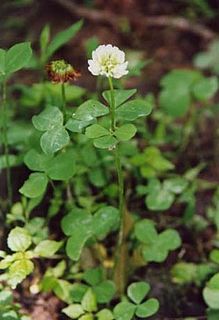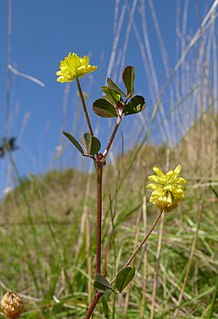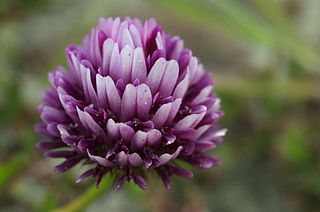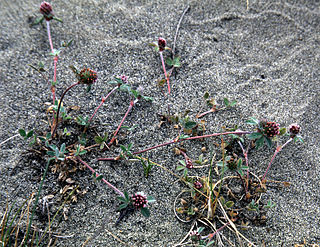
Trifolium stoloniferum, the running buffalo clover, is an endangered species of perennial clover native to the eastern and midwestern United States. From 1940 to 1985 it was believed to be extinct until two populations were discovered in West Virginia. Since then, more populations have been found in the US but it still remains one of the most imperiled plants in North America.

Trifolium campestre, commonly known as hop trefoil, field clover and low hop clover, is a species of flowering plant native to Europe and western Asia, growing in dry, sandy grassland habitats, fields, woodland margins, roadsides, wastelands and cultivated land. The species name campestre means "of the fields".

Trifolium wormskioldii is a species of clover. Its common names include cows clover, coast clover, sand clover, seaside clover, springbank clover, and Wormskjold's clover.

Trifolium hybridum, the alsike clover, is a species of flowering plant in the pea family Fabaceae. The stalked, pale pink or whitish flower head grows from the leaf axils, and the trifoliate leaves are unmarked. The plant is up to 40 centimetres (1.3 ft) tall, and is found in fields and on roadsides – it is also grown as fodder. The plant blooms from spring to autumn. Originating in mainland Europe, it has become established as an introduced plant in the British Isles and throughout the temperate regions of the world.

Trifolium cyathiferum is a species of clover known by the common names cup clover and bowl clover.

Trifolium trichocalyx is a species of clover known by the common name Monterey clover.

Trifolium angustifolium is a species of clover known by the common names narrowleaf crimson clover, narrow clover and narrow-leaved clover.
Trifolium barbigerum is a species of clover known by the common name bearded clover.
Trifolium beckwithii is a species of clover known by the common name Beckwith's clover.

Trifolium depauperatum is a species of clover known by the common names cowbag clover, poverty clover, and balloon sack clover.
Trifolium eriocephalum is a species of clover known by the common name woollyhead clover or hairy head clover.
Trifolium gracilentum is a species of clover known by the common names pinpoint clover and slender clover. It is native to western North America including the west coast of the United States and northwestern Mexico, where it grows in many types of habitat, including disturbed areas. It is an annual herb growing prostrate to erect in form with mostly hairless or slightly hairy herbage. The leaves are made up of lance-shaped to oval leaflets. The inflorescence is an umbel of flowers that spread out or flex downward. The flowers have pink or purple corollas less than a centimeter long.

Trifolium macraei is a species of clover known by the common names Chilean clover, double-head clover, and MacRae's clover. It has a disjunct distribution, occurring on the coastline of Oregon and California in the United States, as well as in South America. It grows in coastal habitat, such as sand dunes, and disturbed areas. It is an annual herb taking a decumbent or erect form. The leaves are made up of oval leaflets 1 to 2 centimeters in length. The inflorescence is usually made up of two oval or rounded heads of flowers each measuring up to 1.5 centimeters wide. Each flower has a calyx of sepals which taper into densely hairy bristles. The flower corolla is purple or bicolored with white or pink.

Trifolium macrocephalum is a species of clover known by the common name largehead clover.

Artemisia norvegica is a species of flowering plant in the aster family known by the common names alpine sagewort, boreal sagewort, mountain sagewort, Norwegian mugwort, arctic wormwood, and spruce wormwood. It is found in cold locations in Eurasia and high altitudes and high latitudes in North America.

Eriogonum visheri is a species of wild buckwheat known by the common names Dakota wild buckwheat and Visher's buckwheat. It is native to the Great Plains in the United States, where it is known from North Dakota, South Dakota, and Montana.
Sisyrinchium sarmentosum is a species of flowering plant in the iris family known by the common names mountain blue-eyed grass and pale blue-eyed-grass. It is native to the Pacific Northwest of North America, where it is known from a part of the Cascade Mountains in Washington and Oregon.
Trifolium leibergii is a species of flowering plant in the legume family known by the common name Leiberg's clover. It is native to Oregon and Nevada in the United States.

Trifolium friscanum is a rare species of flowering plant in the legume family known by the common name Frisco clover. It is endemic to the US state of Utah, where it is known only from Beaver and Millard Counties. It is found growing on the San Francisco Mountains, Beaver Lake Mountains, Wah Wah Mountains and Tunnel Springs Mountains. Most individuals live in the San Francisco Mountains, where the highest point is called Frisco Peak. It was originally described as a variety of Trifolium andersonii in 1978, but was elevated to species status in 1993. It occurs over 250 km (160 mi) away from the nearest T. andersonii.
Entiat Slopes Natural Area Preserve in Chelan County, Washington is part of the Washington Natural Areas Program. It protects 1,920 acres (780 ha) of largely steep terrain dropping to the edge of the Columbia River. It contains one of the largest populations of Thompson's clover, a Washington State threatened species. The site has apparently evolved in response to frequent wildfires.














